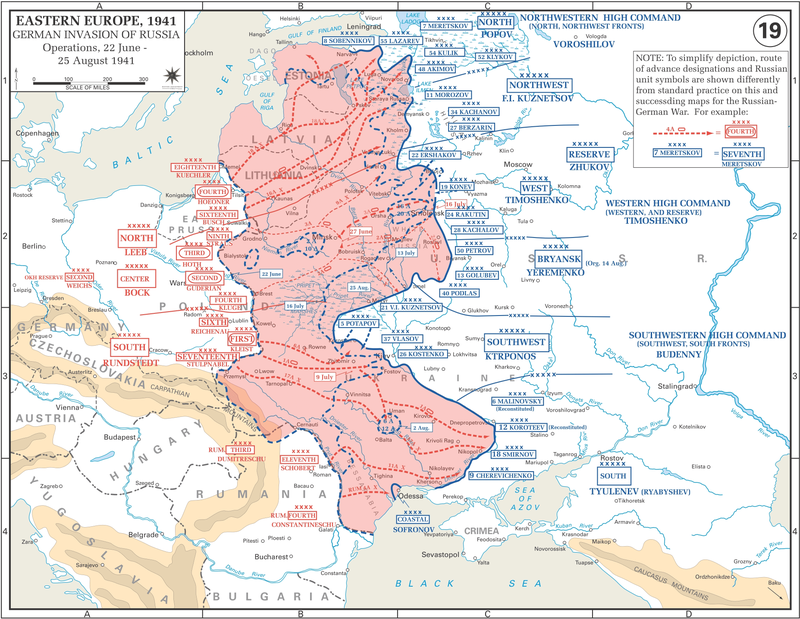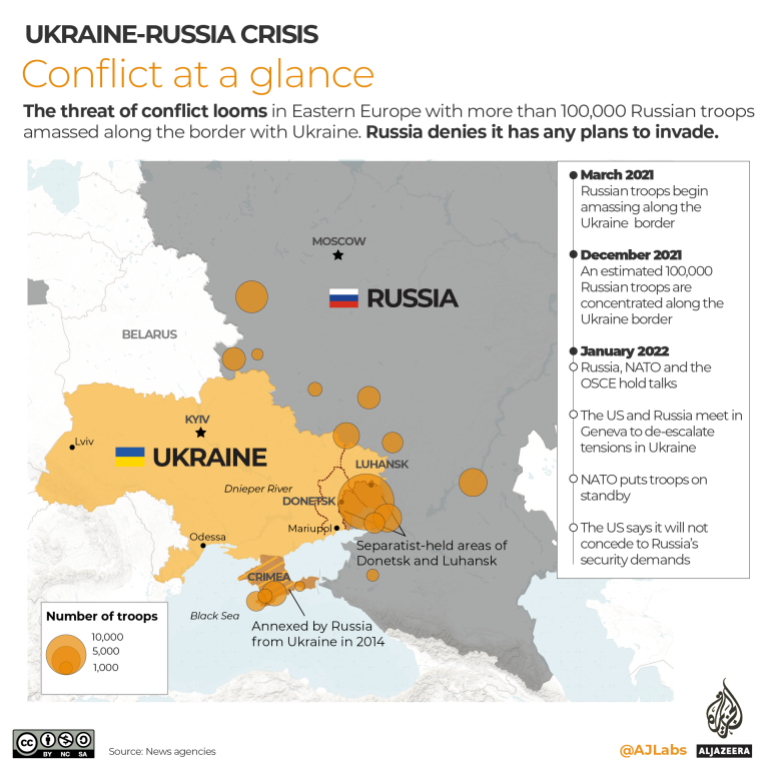人類的戰爭總是發生,但是歷史事件為什麼再度重演?
第二次世界大戰1941-1943.納粹黨的德國軍隊與蘇聯紅軍決戰烏克蘭的基輔,誰人知曉76年後的今日20220228.,又發生烏克蘭的基輔圍城之戰.
歷史的戰爭慘痛的教訓早已忘記,也許今日的俄羅斯與烏克蘭的戰爭,再度成為軍事教材,在日後的記憶或是回憶起,凡是參戰雙方的阿兵哥們,總有說不完的精彩故事,如果它們是戰爭中的幸存者.吾人祈禱戰爭早日結束.
.
.

.1941.的烏克蘭基輔圍城戰爭與2022.年烏克蘭基輔圍城之戰有何不同?

 基輔戰役後蘇軍已經沒有更多後備力量來防衛莫斯科,蘇聯政府調動83個師共80萬人,但只有其中25個師是有足夠裝備,而且缺乏裝甲部隊及戰機,德國方面他們有70個師共200萬人,接近33%是機械化的,這是在戰爭中最高的比例,進攻莫斯科的颱風作戰在10月2日開始。
基輔戰役後蘇軍已經沒有更多後備力量來防衛莫斯科,蘇聯政府調動83個師共80萬人,但只有其中25個師是有足夠裝備,而且缺乏裝甲部隊及戰機,德國方面他們有70個師共200萬人,接近33%是機械化的,這是在戰爭中最高的比例,進攻莫斯科的颱風作戰在10月2日開始。
由於在基輔的巨大勝利,在南方的巨大阻礙已經清除,南方集團軍繼續向頓巴斯進攻,在南方戰區的目的已完全達到,不過向莫斯科的進攻被推遲了4個星期,這在之後的莫斯科戰役中已被証明,雖然在戰術上取得成功,但基輔戰役只能小規模增強德國在戰略上的優勢,因為其主要目的,戰爭的決定性勝利沒有達到。
當蘇軍付出巨大的損失時,他們爭取了時間防守莫斯科,為同盟國取得第二次世界大戰的勝利作出了貢獻。
而且蘇聯在這次及其他包圍戰中得到了教訓,在之後的莫斯科戰役中,他們避免被德軍包圍,之後在史達林格勒戰役中,他們更反而包圍了入侵者。.
. .
.
:Paul Ludwig Ewald von Kleist,1 第二次世界大戰期間納粹德國陸軍元帥。
裝甲部隊快速進攻以完成包圍,這令布瓊尼措手不及,他因此在9月13日被約瑟夫·史達林撤去西南方面軍司令員的職務,沒有人繼任指揮,各軍及師的指揮官各自為戰,9月16日,保羅·路德維希·埃瓦爾德·馮·克萊斯特的第1裝甲集團與海因茨·古德里安的第24裝甲軍在基輔以東120公里的羅克費特沙會師以完成包圍。
之後被包圍蘇軍的命運已被註定,對俄國人來說,包圍圈的範圍難以置信,由於沒有摩托化兵力或軍事天才的領導,他們不可能突破包圍,南方集團軍的德國第17軍團及德國第6軍團與中央集團軍的第2軍團在裝甲部隊的支援下不斷縮小包圍圈,被包圍的蘇軍沒有輕易放棄基輔,在一場殘酷的戰役中蘇軍士兵被德軍火炮、戰車及飛機消滅,最後進攻10天後的9月26日,最後1支蘇軍在基輔以東投降,德軍宣稱俘獲60萬名蘇軍士兵,阿道夫·希特勒說這是歷史上最大的戰役。
.The First Battle of Kiev was the German name for the operation that resulted in a huge encirclement of Soviet troops in the vicinity of Kiev (Kyiv) during World War II. This encirclement is considered the largest encirclement in the history of warfare (by number of troops). The operation ran from 7 August to 26 September 1941, as part of Operation Barbarossa, the Axis invasion of the Soviet Union.] In Soviet military history, it is referred to as the Kiev Strategic Defensive Operation, with the somewhat different dates of 7 July – 26 September 1941.]
Much of the Southwestern Front of the Red Army (commanded by Mikhail Kirponos) was encircled, but small groups of Red Army troops managed to escape the pocket days after the German panzers met east of the city, including the headquarters of Marshal Semyon Budyonny, Marshal Semyon Timoshenko and Commissar Nikita Khrushchev. Kirponos was trapped behind German lines and was killed while trying to break out.
The battle was an unprecedented defeat for the Red Army, exceeding even the Battle of Białystok–Minsk of June–July 1941. The encirclement trapped 452,700 soldiers, 2,642 guns and mortars, and 64 tanks, of which scarcely 15,000 had escaped from the encirclement by 2 October. The Southwestern Front suffered 700,544 casualties, including 616,304 killed, captured, or missing during the battle. The 5th, 37th, 26th, 21st, and 38th armies, consisting of 43 divisions, were almost annihilated and the 40th Army suffered many losses. Like the Western Front before it, the Southwestern Front had to be recreated almost from scratch.
On 30 July 1941, the German forces resumed their advance onto Kiev, with the German 6th army attacking positions between the Soviet 26th army and the Kiev ukrep-raion troops.[] On 7 August 1941, their advance was halted again by the Soviet 5th, 37th, and 26th armies, supported by the Pinsk Naval Flotilla.] With the help of the local population around the city of Kiev, anti-tanks ditches were dug and other obstacles were installed, including the establishment of 750 pillboxes and 100,000 mines planted along the 45 km (28 mi) frontline segment.[8] Some 35,000 soldiers were mobilized from local population along with some partisan detachments and two armored trains.]
On 19 July, Adolf Hitler issued Directive No. 33, which would cancel the assault on Moscow in favor of driving south to complete the encirclement of Soviet forces surrounded in Kiev.[11] On 12 August 1941, Supplement to Directive No. 34 was issued. This directive represented a compromise between Hitler, who was convinced the correct strategy was to clear the salient occupied by Soviet forces on right flank of Army Group Center, in the vicinity of Kiev, before resuming the drive to Moscow, and Franz Halder, Fedor von Bock and Heinz Guderian, who advocated an advance on Moscow, as soon as possible. The compromise required 2nd and 3rd Panzer Groups of Army Group Centre, which were redeploying in order to aid Army Group North and Army Group South respectively, be returned to Army Group Centre, together with the 4th Panzer Group of Army Group North, once their objectives were achieved. Then the three Panzer Groups, under the control of Army Group Center, would lead the advance on Moscow.[] Initially, Halder, chief of staff of the Oberkommando des Heeres (OKH), and Bock, commander of Army Group Center, were satisfied by the compromise, but soon their optimism faded as the operational realities of the plan proved too challenging.[]
On 18 August, the OKH submitted a strategic survey (Denkschrift) to Hitler, regarding the continuation of operations in the East. The paper made the case for the drive to Moscow, arguing once again that Army Groups North and South were strong enough to accomplish their objectives without any assistance from Army Group Center. It pointed out that there was enough time left before winter to conduct only a single decisive operation against Moscow.[
The Panzer armies made rapid progress. On 12 September, Paul Ludwig Ewald von Kleists 1st Panzer Group, which had by now turned north and crossed the Dnieper river, emerged from its bridgeheads at Cherkassy and Kremenchuk. Continuing north, it cut across the rear of Semyon Budyonnys Southwestern Front. On 16 September, it made contact with Guderians 2nd Panzer Group, advancing south, at the town of Lokhvitsa, 120 mi (190 km) east of Kiev.[21] Budyonny was now trapped and soon relieved by Joseph Stalins order of 13 September, and Budyonny was replaced by Semyon Timoshenko, in command of the Southwestern Direction.
After that, the fate of the encircled Soviet armies was sealed. With no mobile forces or supreme commander left, there was no possibility to effect a breakout. The infantry of the German 17th and 6th Armies, of Army Group South, soon arrived, along with the 2nd Army, also on loan from Army Group Center, and marching behind Guderians tanks. They systematically began to reduce the pocket, assisted by the two Panzer armies. The encircled Soviet armies at Kiev did not give up easily. A savage battle in which the Soviets were bombarded by artillery, tanks, and aircraft had to be fought before the pocket had finally fallen.
By 19 September, Kiev had fallen, but the encirclement battle continued. After 10 days of heavy fighting, the last remnants of troops east of Kiev surrendered on 26 September. Several Soviet armies, namely the 5th, 37th, and 26th, were now encircled, as well as separate detachments of 38th and 21st armies.[8] The Germans claimed to have captured 600,000 Red Army soldiers (up to 665,000),[8] although these claims have included a large number of civilians suspected of evading capture.
During withdrawal from Kiev, on 20–22 September 1941, at Shumeikove Hai, near Dryukivshchyna, (today in Lokhvytsia Raion) several members of headquarters staff perished, including Mikhail Kirponos (commander), Mikhail Burmistenko (a member of military council), and Vasiliy Tupikov (chief of staff).[8] Some 15,000 Soviet troops managed to break through the encirclement.[
| Battle of Kiev (1941) | |||||||||
|---|---|---|---|---|---|---|---|---|---|
| Part of Operation Barbarossa on the Eastern Front of World War II | |||||||||
 Explosion of a Soviet radio-mine in Kiev (September 1941) | |||||||||
| |||||||||
| Belligerents | |||||||||
| Commanders and leaders | |||||||||
| Strength | |||||||||
| 25 infantry divisions 9 armoured divisions 544,000[1] | Initial 627,000[2] | ||||||||
| Casualties and losses | |||||||||
| Total: 61,239[3] 12,728 killed 46,480 wounded 2,085 missing |
700,544 men[2]
343 aircraft destroyed[4] 28,419 guns and mortars lost[5] | ||||||||
.
.
基輔戰役是第二次世界大戰中在烏克蘭的一場大型包圍戰;今天它被認為是歷史上最大規模的包圍戰,它作為巴巴羅薩作戰在1941年8月23日]至9月26日,在蘇聯歷史中它被稱為基輔防禦戰役(Киевская оборонительная операция),發生在1941年7月7日至9月26日。
幾乎整個蘇聯紅軍的西南方面軍被德軍包圍,共有66.5萬名蘇軍被俘虜,德軍在基輔的包圍圈未被嚴密封鎖,小股蘇軍在德軍緊閉包圍圈後突破包圍逃脫,包括謝苗·布瓊尼元帥、謝苗·康斯坦丁諾維奇·鐵木辛哥元帥及政治委員赫魯雪夫,無論如何這是蘇軍前所未有的大敗,超過了在6月至7月間在明斯克的災難,9月1日,西南方面軍有75.2萬至76萬人(85萬人包括後備及後方服務部隊)、3,923門火炮及迫擊砲、114輛戰車及167架飛機,被包圍的包括45.27萬人、2,642門火炮及迫擊砲和64輛戰車,10月2日,有15,000人從包圍圈突圍,西南方面軍共付出700,544人傷亡,包括616,304人在長達1個月的戰役中陣亡、被俘或失蹤,結果蘇聯4個軍團(第5軍、第37軍、第26軍及第21軍)共43個師被消滅,第40集團軍被嚴重削弱,與之前的西方面軍相似,西南方面軍需要重建,













